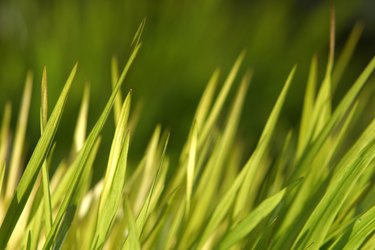
The word grass comes the middle English word "gras" or the high German word "gras," meaning herbage suitable for grazing animals, or plants with jointed stems, slender sheathing leaves and flowers borne in spikelets. Several grass-like plants have bulbous roots and are often mistaken as grasses. Wild garlic and nutsedge are common grass-like plants with bulbs, but reside in different plant families. Onion grass and bulbous bluegrass are true grasses that have bulb-like structures underground.
Wild Garlic and Wild Onion
Video of the Day
You can see wild garlic, or Allium vineale, and wild onion, Allium canadense, growing in bunches in lawns, flower beds, fields and nurseries. Both are members of the Liliaceae family, or Lily family and are often mistaken for grasses. Wild onion has a hollow stem, while wild onion leaves are flat. The underground bulbs are their primary means of propagation, but both plants will also set seed if allowed to mature. Controlling wild garlic and onion is best done by digging out the bulbs, or using a post-emergent herbicide such as 2, 4-D.
Video of the Day
Nutsedge
Nutsedge, or Cyperus esculentus, reproduces by underground structures called tubers, and it is rare to find a true nutsedge seedling. The tubers are 1 to 2 cm long, rounded and scaled, being white first, then turning to brown. The leaves resemble grasses and the plants form dense populations. Although superficially nutsedges resemble grasses, they are classified in the Cyperaceae, or Sedge family. Nutsedge is very difficult to control, and is problematic in agricultural situations.
Onion Grass
Onion grass, or Melica bulbosa, is a perennial grass that can be found in meadows, alluvial fans, rocky woods and hills. You can usually locate this North American native on northern and eastern exposures with rich, sandy loam soils at mid- to high elevations. The base of this grass has a specialized culm, or stem, base that is bulbous, hence the species name "bulbosa." These are not true bulbs that lie underground and help with reproduction. Onion grass is a good forage grass for cattle, sheep, horse, elk and deer.
Bulbous Bluegrass
Bulbous bluegrass, or Poa bulbosa, was once used for turf, erosion control and pasture, but is now considered weedy. Bulbous bluegrass is aptly named for the underground bulbs that help this grass reproduce and spread. As a short-lived perennial, this is the only known true grass species to have underground bulbs. As a member of the Poaceae family, bulbous bluegrass can be found in all temperate and sub-tropical regions and is often found along roadsides, hay and crop fields.